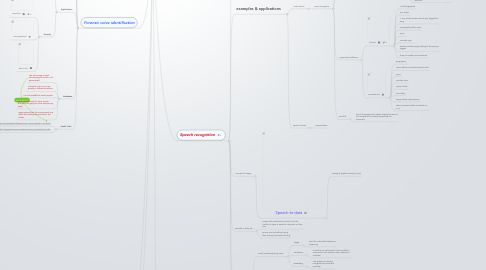
1. Forensic voice identification
1.1. Defintion
1.1.1. (According to the wikipedia)Is the identification of the person who is speaking by characteristics of their voices (voice biometrics).
1.2. Principle
1.2.1. Every voice is individually characteristic enough to distinguish it from others through voiceprint analysis.
1.3. Advantages
1.3.1. Voice is unique, it is hard to simulate(It's quite safe).
1.3.2. It is easy to use.
1.4. Applications
1.4.1. Identification
1.4.1.1. Identify the criminals
1.4.1.2. As a ID card
1.4.2. Security
1.4.2.1. USB drive
1.4.2.2. Voice password
1.4.2.3. Door Lock
1.5. Limitation
1.5.1. The technology are still developing(The result is not guaranteed).
1.5.2. Individual's voice can vary greatly in different situations.
1.5.3. It is not available to dumb people.
1.5.4. voice can be simple to tape. Hence, strangers can get your voice sample very easily.
1.5.5. Noise comes from the environment may affect the result(quite sensitive to the noise).
1.6. Useful Links
1.6.1. http://www.cam.ac.uk/research/features/can-a-voice-identify-a-criminal/
1.6.2. http://expertpages.com/news/voiceprint_identification.htm
2. http://www.streetdirectory.com/travel_guide/139545/technology/key_differences_between_speech_recognition_and_voice_recognition.html Differences between voice identification & speech recognition
3. Future Uses
3.1. Voice-activated assistants
3.2. intellectual control
3.2.1. Cars, robots and other electronic appliances
4. Background & History
4.1. Forensic voice identification
5. Speech recognition
5.1. Definition: determining what is being said
5.2. examples & applications
5.2.1. Audio search
5.2.1.1. Music recognition
5.2.1.1.1. Limitations
5.2.1.1.2. Principle of design
5.2.1.1.3. Applications/software
5.2.1.1.4. Benefits
5.2.2. Speech-to-text
5.2.2.1. Demostration
5.3. Principle of design
5.3.1. Speech-to-data
5.3.1.1. analog-to-digital converter (ADC)
5.4. Benefits in daily use
5.4.1. People with disabilities (visually or lost his hands) can type in words to computer on their own
5.4.2. Drivers can dial without using their driving hands while driving
5.5. Two categories
5.5.1. Small-vocabulary/many-users
5.5.1.1. Usage
5.5.1.1.1. ideal for automated telephone answering
5.5.1.2. Limitations
5.5.1.2.1. limited to a small amount of pre-installed commands, such as basic menu options or numbers.
5.5.1.3. Rewarding
5.5.1.3.1. The system can always recognize the command precisely
5.5.2. Large-vocabulary/limited-users
5.5.2.1. Usage
5.5.2.1.1. work best in a business environment where only a small number of users use it
5.5.2.2. Limitations
5.5.2.2.1. The systems need to be trained first( to recognize the user's voice
5.5.2.2.2. only works with a small amount of users
5.5.2.2.3. accuracy rate will fall drastically with any other user
5.5.2.3. Rewarding
5.5.2.3.1. vocabularies in the tens of thousands
5.5.2.3.2. good degree of accuracy (85 percent or higher with an expert user)
5.6. Weaknesses and Flaws
5.6.1. Low signal-to-noise ratio
5.6.1.1. Causes
5.6.1.1.1. Low-quality sound cards
5.6.1.1.2. Works in a noisy contex
5.6.1.2. Noise will interfere the waves which the system is going to recognize
5.6.2. Overlapping speech
5.6.2.1. Current systems have difficulty separating simultaneous speech from multiple users
5.6.3. Homonyms
5.6.3.1. Definition: two words that are spelled differently and have different meanings but sound the same.
5.6.3.2. CAN'T tell the difference between these words based on sound alone
5.6.3.2.1. examples of homonyms:
5.6.3.3. extensive training of systems can improve the performance
